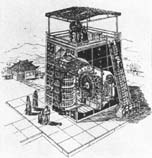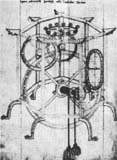Astronomical Clocks

Su Sung's Clocktower.
From "Heavenly Clockwork" by Needham, Ling, and Price

Dondi's Clock, Motion Work
From "Some Outstanding Clocks Over Seven Hundred Years, 1250-1950."

Baldewin's Planetary Clock, The Calendar Dial.
From "Some Outstanding Clocks Over Seven Hundred Years, 1250-1950."

Astronomical Clock
Manufactured by Universal Clock Co.
Clockmakers, even the very early ones, have always been interested in the construction of mechanisms to register not only the hours and minutes, but also the movements of the sun and other celestial bodies.
As early as 1090 Su Sung, a Chinese, built an astronomical clock tower. It stood some thirty feet high with another ten foot section above it for observing instruments mounted on a platform. Operated by water power, the observing instruments on top of the observation platform were mechanically rotated and constantly pointed at the moving heavenly bodies. In a chamber below, a marked star-globe rotated automatically to provide the astronomer with a microcosm of the movements of the stars and planetswithout going outside to observe them, an ideal arrangement when weather conditions prevented direct observations.
In those early times few had the knowledge and ability to build clocks. Still fewer could compute, design and construct the intricate gear trains necessary for an astronomical model. Costs were comparatively high so we find that early clocks were individually built for a specific purpose. Many functioned as public timepieces and were placed in a church or public building for that purpose.
A very famous weight driven astronomical clock was built by Giovanni de Dondi in Padua, Italy between the years of 1348 and 1362. Its size was such that it required a large room to accommodate it. Heptagonal in design, one planet appeared on each of its seven sides with the planetarium on top. In 1440 a mention of this clock appeared in the writings of Michele Savronarola. During the years of 1556 and 1557 it was removed to the Convent of San Yste in Spain and eventually destroyed by fire in 1809.
Another very famous astronomical clock was built by Eberhart Baldewin in 1561 for Landgraf William IV of Hesse. In this instance the calculations for the clock were made by the Landgraf and his Astronomer, Andreas Schoener. Dials were provided for Mars, Venus, Mercury, Saturn, Jupiter, Moon, ar Astrolabe and one for the calendar dial. On the top of the clock a celestial globe was mounted.
The fictional writings of Jules Verne are rapidly becoming realities of today. Successful flights orbiting the earth, active preparations for journeys to other planets, the considerable area of new knowledge we have acquired about outer space, all have created an upsurge of interest in the universe around us. So we, in the space age, are vitally interested in the various kinds of time which the astronomical clocks of old foretold.
As of today the astronomical clock is no longer a rare museum piece. The scientific background and skills of Dr. Spilhaus, combined with the use of modern materials and manufacturing methods by Edmund Scientific Co., have converted the complex arrangement of heavy mechanical parts into a concise mantle clock of pleasing design and decor. Entirely functional, reliable and esthetically pleasing, the Spilhaus Space Clock is well within the reach of many. It is a possession to be proud of (we believe it will become a collector's item) and as a conversation piece it has no equal.
More pictures of Spilhaus Space Clock and how to repair it.
